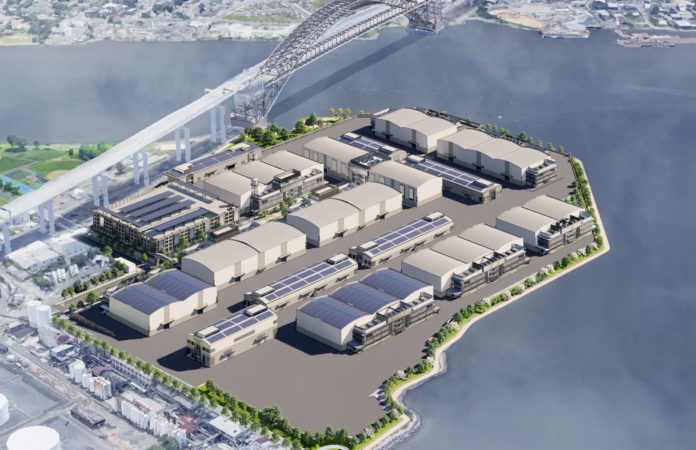
The Bayonne Planning Board has approved an application by 1888 Studios, LLC to reconfigure their final site plans for the planned major motion picture and television studio.
The studio is to be constructed on the former Texaco site at the terminus of Avenue A. At the southernmost tip of Bayonne, the site is surrounded by the Bayonne Bridge to the east, the Caschem West site to the north, and the Kill Van Kull to the west and south.
The Planning Board previously approved the initial final major site plans for 1888 Studios back in March. Since then, the plans have gotten rave reviews from industry insiders, and project officials estimate the nearly $1 billion project is an investment in the city that will bring hundreds of millions of dollars to Bayonne, to be supported by a long-term payments-in-lieu-of-taxes agreement and millions in general aggregation redevelopment bonds.
However, at a community meeting on the project, the renderings of the project appeared to have changed from the March planning approval. At the January meeting of the Planning Board, 1888 Studios presented the changes previously seen in those renderings for official approval by the board.
The application was presented by attorney Matthew Posada, who again described the ground-up motion picture project as “the largest in North America” of its kind in the sense that studios are normally not constructed with all buildings in once location at the same time. He described how the plans have changed since March as the project moves forward.
“This application received site approval back on March 30, 2022 and since that date, we have been working in partnership with the City of Bayonne in order to bring this project to fruition,” Posada said. “As part of that process, there’s some fine tuning that we need to do before we actually submit for pulling building permits.”
Approved changes reimagine site layout
1888 Studios was sought and was granted an amended preliminary and final major site plan approval to reconfigure the previously approved site layout. This included the elimination of the underground parking spaces and structures, the screening and post-production office building, the creative office building, and the central utility plant and associated utility yard.
The previously approved stage buildings have been reconfigured in size and location for use optimization and better site circulation. This is intended to meet the anticipated needs of the motion picture and television studio complex.
“Part of those revisions includes… reducing the building count from 19 to 17, and the elimination of the post-production building, creative office building, and central utility plant,” Posada said. “We’re also going to be eliminating subterranean parking, and we’re doing an above-ground parking garage.”
The new garage parking will be in addition to parking spaces and lots surrounding the studio buildings. Otherwise, nothing else major had changed with the application and other things related to it, such as the use of union labor and the planned apprenticeship program for local youth.
“The proposed studio complex is still 22 million gross square feet and will still be the largest ground-up movie studio complex in North America,” Posada said. “We’re still going to be providing approximately 2,500 construction jobs. We are in favor of being pro-union. We do anticipate having approximately 2,520 employees at peak time. We will also still be providing apprenticeships to the young adults of the city of Bayonne.”
Posada said that 1888 Studios had received all official reports and agreed with all comments and requests in them. For any item not agreed on, He said that later testimony would explain from the six project experts.
Posada also noted that there were three design waivers being asked for, regarding the height of the lighting at the site, the foot candles or intensity of the lights, and the required landscaping in the parking lots under the redevelopment plan.

Project experts testify to changes
Architect Michael White from the firm Gensler testified to the architectural changes in the site plans. He said that at Gensler, the largest architectural firm in the world, he is responsible for working on currently over 30 film studios around the world from London, to Toronto, to Asia and the Middle East.
White said Togus Urban Renewal has put an emphasis on site context and the way it meets the water when it comes to the 1888 Studios project. He said the way it meets nature at the water’s edge is unique and exciting, as well as the incorporation of the city’s street grid into the studio complex layout.
White said continuing the city street grid pattern, the view corridors, and terminating Avenue A into the site was an important part of the application. He also touted the nature of the site as different than the typical for film studios, with the Bayonne Bridge and Kill Van Kull providing built-in film sets in addition to the sound stages.
White reiterated that 1888 Studios’ name comes after the year Thomas Edison invented the motion picture camera. He explained that amid the layout changes, the studio buildings will remain in an art deco style, reminiscent of the era in time when film making flourished in Los Angeles and the look became a signature of historic film studios.
“This idea of storytelling, film making, and respect for the past is something that reaches deep into the development of this design,” White said. “If you look at the quality of the buildings that Togus has invested in, these are high quality buildings… they’re not boring boxes.”
White said Togus has been focused on thinking about the pedestrian experience because they wanted a high-quality experience for the employees working there. He hoped they would mostly be from Bayonne too.
According to White, the changes were prompted by feedback from other film studios. They made suggestions that 1888 Studios seeks to incorporate to maximize efficiency.

Maximizing efficiency after feedback from other studios
“We had an opportunity to present this project to some of the top film studios in the world who have expressed interest in what we’re doing here, and we’ve gotten a lot of feedback from them,” White said. “It really allowed the project to evolve. So some of the things that Matt had mentioned about how the project is evolving is what we’re learning from them. There is an evolutionary process that’s happening and the way people are thinking about how we make the studio a lot more productive. So from a production standpoint, there is starting to become a diminished need for straight stand-alone office buildings and an increased need in what we call flex studio and production support buildings, which are buildings that have stages and the office building of the stages…that is really what motivated the removal of the office buildings.”
White said flex space is a sound stage where films and television are produced, and a flexible office space adjacent to that where employees walk directly into without going outside. The office space is flexible in the use in that it can be used for writers, producers, directors, actors, dressing rooms, hair and makeup, and wardrobe, among others.
According to White, in addition to the new five-story parking garage, the rest of the parking would consist of small parking lots and spaces scattered throughout the site including the reduction of the back lot and increase in parking nearby. He said that despite the change, the applicant is still planning more parking than required with a total of 2,158 spaces.
“This is a very large campus and the idea around the studio lot is that there will be people who will be working on one part of the site at a certain part of the day, … driving across the site to a stage and then working there. So you need parking spaces that are spread out over the lot to accommodate that that type of flexibility so that you’re not maxed out on those spaces. The other reason is we’re providing some flexibility to the site where for filming, because you never know quite what a director is going to want to do… When you start filming, sometimes you need space where you can have the cameras and crews and so the idea is building in some resiliency into the block where you’re not packed in so tightly.”
White said the parking count is sufficient because people do not arrive at the same time like a 9 to 5 job. He said that some crews may arrive at 8 a.m. while others arrive at 10 a.m. depending on their role in the shoot.
“It really allows the flow of the people in and out of the studio to be much more gradual than a peak flow travel,” White said.

Design waivers requested for lighting and landscaping
When it comes to parking lot lighting, White explained why the studio was requesting a design waiver. He said that the 30 foot light poles would cast shadows, would require a larger number of poles than the 62 foot light poles proposed, and thus would limit circulation on the site for larger vehicles.
“We’re parking star wagons or star trailers or trucks that are taller in height and a 30 foot high light fixture will cast shadows where a 62 foot light allows us to provide more ample lighting into the facility,” White said. “It’s a very, very functional and practical reason for going with the larger fixture.”
On sustainability, White said the goal was for 1888 Studios to get LEED Silver Certification. He noted they would achieve this without landscaping in the parking lots, which would also limit circulation.
“We are really focusing on the performance of energy modeling to maximize the building systems,” White said. “We’ll be looking at life cycle analysis and performance, and we’ll be looking at sustainable materials.”
Consulting City Planner Mika Apte asked that with the removal of the two office buildings, which were more outwardly Art Deco in nature than the other buildings, how the theme would be kept with the other buildings. White said that the other buildings are still very much planned in an Art Deco style.
“So the flex building is highly articulate,” White said. “Those buildings front the entire waterfront all the way. Our goal was to maintain that Art Deco flair all along the water’s edge where we removed the office building, so you would have a building of this high quality Art Deco defenestration replacing the office building on that water frontage.”
Apte asked if there would be any solar panels or green roofs under the new plan. Posada said there would no longer be green roofs, only solar panels on 26.3 percent of roof coverage. He said green roofs are not required with less than 100 percent impervious coverage, of which the site is only at 90.13 percent.
Apte asked if parking spaces totaling 2,158 were sufficient. White said that its an industry standard ratio and percentage and emphasized the need for the open space parking lots for filming-related purposes.
“A lot of the parking you’ll notice is the open space around the buildings, which is important from a film studio standpoint,” White said. “To be able to have some flexibility around the stages so that you can roll sets out when you’re not doing that, you can park cars there so it provides some resiliency. Then we can park cars there when we’re not putting up a set or moving a set or parking a truck or a star wagon there… If not there, that car could park in the garage and you have a star wagon… From a ratio standpoint, these are consistent ratios that we see provided in most studio lots that we do.”

Inside the planned film studio complex
Apte asked if the star wagons would primarily be parked on the back parking lot at the northwest of the site, which Posada confirmed.
The other architect from Gensler, Matt Cornett, echoed much of White’s testimony. He said that three buildings were removed, including the creative office, the post-production office, and the central utility plant. The other change was the removal of the subterranean parking an addition of the new parking garage.
Cornett explained that there are three types of buildings at the site. He said that mill buildings are where set pieces and props are constructed, that sound stages are where filming takes place, and that flex space attached to the sound stages is where support offices for writers, producers, and directors, and more is located. He said there are one-off building such as the two-story mill building with lighting grip storage.
The sound stages range in size from approximately 18,500 square feet (about four times the area of a basketball court) to about 61,500 square feet (about half the area of a Manhattan city block). The mill buildings range from approximately 22,000 square feet to 34,000 square feet. The flex buildings go from approximately 25,000 square feet to about 40,000 square feet. The garage is approximately 102,000 square feet.
The sound stages are all approximately 62 feet tall, with the tallest being 70 feet. The mill buildings are typically 48 feet tall, with the tallest being 60 feet. Flex buildings are approximately 60 feet tall, with the four story flex spaces totaling about 81 feet. The top of the garage is 73 feet tall. The rooftop mechanical units and solar panels will be screened by walls and not visible from the ground.
Cornett explained that the design waivers for the intensity of the lights was to allow a 1.6 footcandle light as opposed to a .5 footcandle light permitted in the redevelopment plan. He said the higher footcandle makes the site safer by increasing visibility.
He echoed White that the increased height of the light poles, the second design waiver, was to reduce shadows and the number of the poles in the parking lot increase circulation among larger vehicles. Cornett added that the site did not require green roofs due to the 90.13 percent of impervious coverage being lower than the 100 percent that would trigger the need for green roofs or solar panels. Regardless, 1888 Studios is still providing 26.3 percent of solar panel coverage on all roofs.

Engineering experts reiterate planned changes
Sanjay Patel civil engineer from PS&S echoed testimony from other project experts. Patel noted that the site was 74 acres total, with 58 acres of that being land and 16 of it being water.
Patel said there are three easements on the site, one for PSE&G to the north, one for Veolia in the middle of the site, and a gas line to the south. He said the site will consist of 17 buildings with 10 studio, 5 mill buildings, and a parking garage, as well as the split mill and light grip storage building, and the not-included-in-the-count utility substation and trash and recycling building.
“This is an outstanding project, and a great reuse of a formerly contaminated site,” Patel said.
Apte asked if the heliport was still being proposed, noting her report was the only one not answered by the applicant yet as opposed to the others already answered, thus the questions. Posada confirmed that the heliport, a ferry terminal, and a pier were not being proposed now but not off the table in the future, which Apte confirmed with him would require further Planning Board approval.
Posada also confirmed to her that the park and waterfront walkway remain, yet that there is not any employee recreation on site but that the base camps throughout the site in front of each building can be used as such and would work with the city on that. In response to other questions, he said there would still be four loading docks with the same loading pattern, that 1888 Studios would comply with landscaping comments, electric vehicle parking, and that a package regarding the site signage would be sent to the board at a later date once tenants have been identified.
Posada explained that 1888 Studios would work with city officials and Conrail to come up with a plan for streetscape renovations outside the site along Avenue A and the adjacent rail line. Following that, the fourth expert to testify was engineer Craig Hermann, also from PS&S.
Instead of utility building and a social utility yard, now a utility substation is planned with a smaller trash and recycling building. He reiterated that the offices were removed in lieu of other buildings for “greater effect” of the site.
Hermann said the due to the parking changes there are now some grade changes at the site. Previously, the redevelopment area was going to be raised to between 25 and 27.5 to incorporate the underground parking. Now it is only being raised to between 15 and 17.5 lower because there is now plans for above-ground parking.

Traffic impact lessened by reconfiguration
Traffic engineer Dan DiSario said that because the offices were removed for increased site efficiency, there would be less buildings with a reduction of 400,000 square feet. That reduction will yield less traffic he said.
According to DiSario, trips will be in the morning and evening both by 1,100 to 700 at peak hours. Due to this reduction, the plans have changed from a traffic light at Avenue A and West 1st Street to an all way stop sign. However, Posada said that 1888 Studios will provide a traffic light if it is required. He added that employees will have a transportation coordinator to manage on site flow.
Apte asked how the trips were reduced, to which DiSario said traffic continues to be C or better under the study which he said was acceptable. Mack asked why the need for all the parking if there will be a reduction in trips, to which he said there is no need to stripe all of the parking across the site, but they want to make it official for ease of access to each building.
DiSario added that a studio like this “doesn’t exist anywhere in the country” and is going to be a “landmark project.” The striping is to define the space that would likely be used for parking anyway regardless.
Mack asked what the required trip count was for a traffic light, to which DiSario said 1,200 trips on Avenue A, and 100 on West 1st Street. However, this ignores that employees arrive at staggered times, with no dedicated morning or evening rush he said.
Then project planner John McDonough concluded the testimony by highlighting many of the points raised by previous project experts. He said the requested design waivers are actually variances for the “special project” that will bring another “world-class facility” to Bayonne.
McDonough said the form of the site is largely the same spare for some “design refinements” to make the site “better and operate more efficiently.” He said brighter lights are better than dimmer, that the port lights nearby are just as tall as they would propose, and that 1888 Studios would be aiming for LEED Silver certification.

Board approves application unanimously
In closing, Mack touted the cooperation with the development team, Conrail, and the Port Authority of New York and New Jersey. She said that PANYNJ is allowing the connection from the new park to Dennis Collins Park on the other side of the Bayonne Bridge through the waterfront walkway underneath.
Chairwoman Karen Fiermonte said it was a huge benefit to the city, considering the apprenticeships and other things. She jokingly wished she had a time machine to fast forward
Commissioner Ahmad Lack said he is very excited for the project to come to fruition. He also noted that other than the economic impact on the city, there would be the social impact on students because Bayonne has a robust drama scene and a project of this scale would have a positive affect psychologically.
The commissioners present voted unanimously to approve the project including: Fiermonte, Lack, Sectetary George Becker, City Councilman At-Large Loyad Booker, Michael Quintela, and Jack Berio. Commissioner Ramon Veloz and Vice Chairwoman Maria Valado were absent and did not vote.
Officials previously said the project is set to break ground by contractor Turner Construction later this year. In the meantime, the site is being remediated and graded in preparation.
For updates on this and other stories, check www.hudsonreporter.com and follow us on Twitter @hudson_reporter. Daniel Israel can be reached at disrael@hudsonreporter.com.










